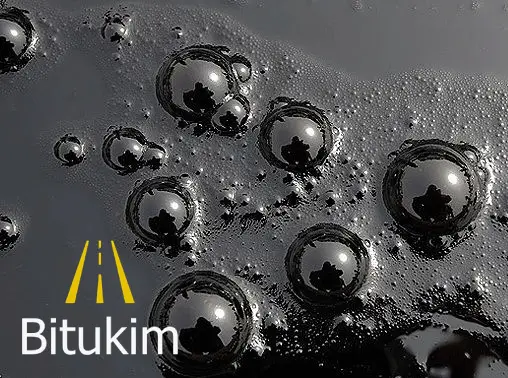Anionic Emulsion

Description of Anionic Bitumen Emulsion
Anionic bitumen emulsion is a stable dispersion of bitumen droplets in water, where the surface charge of bitumen particles is negative. This negative charge arises from the presence of anionic surfactants, such as soap, which coat the bitumen droplets and prevent them from coalescing. The formulation typically includes water, bitumen, emulsifying agents, and sometimes additives to enhance its performance.
Application of Anionic Bitumen Emulsion
- Prime Coating: Anionic bitumen emulsion is commonly used as a prime coat to prepare the base surface before overlaying with asphalt. It acts as a bonding agent, improving the adhesion between the existing pavement and the new asphalt layer.
- Tack Coat: Tack coats are essential to ensure a strong bond between different layers of asphalt during road construction. Anionic emulsions are widely employed for this purpose, providing excellent bonding capabilities.
- Surface Dressing: Surface dressing involves the application of a thin layer of bitumen emulsion and a layer of aggregate chips to rejuvenate and protect the existing road surface. Anionic bitumen emulsions are preferred due to their ability to coat aggregates effectively.
- Cold Mix Asphalt: Anionic emulsions play a crucial role in the production of cold mix asphalt, which can be used in various weather conditions and remote locations without the need for hot mix plants.
Advantages of Anionic Bitumen Emulsion
- Environmental Friendliness: Anionic emulsions are water-based and produce minimal emissions, making them more environmentally friendly than traditional hot mix asphalt.
- Versatility: These emulsions can be used with a wide range of aggregates, making them suitable for various construction applications.
- Improved Bonding: Anionic provide better adhesion and bonding between bitumen and aggregates, resulting in durable road surfaces.
- Reduced Energy Consumption: Compared to hot mix asphalt, using anionic emulsions requires less energy for heating and mixing, contributing to energy conservation.
- Cold Application: Anionic emulsions can be applied at lower temperatures, allowing construction projects to proceed even in adverse weather conditions.
Anionic Emulsion Properties
- Particle Charge: As mentioned earlier, anionic bitumen emulsions have a negative particle charge. This property allows them to remain stable in water and ensures easy mixing with aggregates during road construction.
- Particle Size: The average particle size of bitumen droplets in anionic emulsions can vary but typically falls in the range of 0.1 to 10 micrometers. Smaller particle sizes provide better coating and penetration properties, leading to superior bonding with aggregates.
- Setting Time: Anionic bitumen emulsions exhibit a controlled setting time, which can be adjusted by altering the emulsifying agents’ composition. This feature allows for flexibility in construction processes, enabling precise control over the curing time.
Specification of Anionic Emulsion
Anionic bitumen emulsion is a type of bitumen emulsion where the bitumen particles are negatively charged. Here are some specifications and characteristics of anionic bitumen emulsion:
1. Composition:
- Anionic emulsion consists of bitumen (asphalt), water, emulsifiers, and additives.
- The emulsifiers used in anionic emulsions are designed to create a stable dispersion of bitumen in water with negatively charged particles.
2. Charge:
- Anionic emulsion particles carry a negative charge, which helps in their stability and dispersion in water.
- The negative charge of the particles allows them to adhere well to aggregates and surfaces with a positive charge, enhancing the bonding properties.
3. Viscosity:
- Anionic emulsion typically has a lower viscosity compared to cationic bitumen emulsions, making it easier to handle and apply.
- The lower viscosity allows for better coating and penetration into aggregates during mixing and construction processes.
4. Application Temperature:
- Anionic emulsions are suitable for use in cold mix applications, where mixing and compaction can be done at ambient temperatures.
- They can also be used for chip seal, tack coat, fog seal, and other surface treatments.
5. Setting Time:
- Anionic emulsions have a relatively slower setting time compared to cationic emulsions, allowing for extended workability and application windows.
- The slower setting time is beneficial for applications that require longer open times or curing periods.
6. Compatibility:
- Anionic emulsions are compatible with a wide range of aggregates and can be used in various construction applications.
- They are commonly used in road maintenance, pavement preservation, and surface treatment projects.
7. Storage and Handling:
- Anionic emulsions should be stored in a cool, dry place away from direct sunlight to prevent degradation.
- Proper handling procedures should be followed to avoid skin contact and inhalation of fumes during application.
8. Quality Standards:
- Anionic emulsions should meet relevant industry standards and specifications, such as ASTM D977, AASHTO M140, or local regulatory requirements.
- Quality control measures should be implemented during production, transportation, and application to ensure consistent performance.
Overall, anionic bitumen emulsion offers advantages such as good adhesion, compatibility with various aggregates, extended workability, and ease of application in cold mix scenarios. Understanding the specifications and characteristics of anionic bitumen emulsion is essential for successful use in construction projects.

